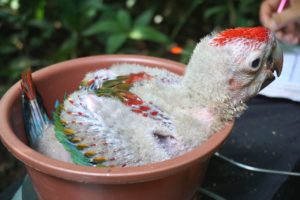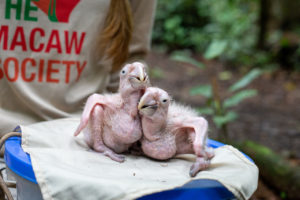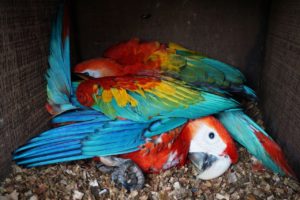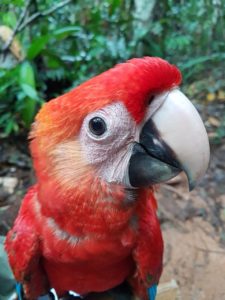
The long renowned team working from the Tambopata Research Center in Perú has moved down river to the Malinosky Biological Station, which is owned and operated by the Peruvian government. Here is an update about the great works of the Macaw Society, written by Roshan Tailor and edited by Don Brightsmith and Gabriela Vigo-Trauco.
Tambopata Conservation & Research
The Macaw Society has been researching and advancing the conservation of the scarlet macaw (Ara macao macao) inside the Tambopata National Reserve, southeast Perú, for over 20 years. Scarlet macaws, though not classified as under threat of extinction, are iconic. Unfortunately, they are under continual threat from habitat loss due to agriculture, mining, and logging. Therefore, they warrant continued conservation efforts. Since these parrots help disperse seeds to facilitate forest regeneration, their conservation benefits the whole ecosystem.
Amazon deforestation severely threatens large trees which significantly impacts the macaws, as reproductive success is often limited by the availability of natural cavities. As those become less available, artificial boxes help populations to grow. These also facilitate the ability to study breeding ecology and behavior with better access to the chicks and nests. It’s also easier to install surveillance cameras and sensors on artificial nests. To date, over 85% of the macaw nesting data comes from artificial nests.
The Macaw Society has experimented with concrete, PVC, and wood nests. PVC and wood have proved to be the most successful. Currently, 9 wooden nests, 12 PVC nests, and an additional 20-plus natural cavities are being monitored. In 20 years, over 300 chicks have successfully fledged! The success of these efforts is confirmed when adult macaws bearing bands placed on them as chicks are located.
Saving Macaws One Chick at a Time

Between 2007 and 2017, the Macaw Society researched why macaw chicks die in their nests. Cameras placed inside nests transmitted a live feed, showing that some chicks were predated and some succumbed to disease, but approximately 20% died due to starvation. So, chicks with a high probability of starving to death were taken out of nests and relocated to foster parents. This was followed by regular monitoring to ensure that the foster chick was accepted,and the new parents were feeding it. Some chicks were given supplementary feeding so that all chicks could maintain a similar weight. All the chicks were accepted by new parents, and nearly all successfully fledged. In three seasons running the program, almost 30 chicks were saved from starvation. Thus, through provisioning of nests and chick relocation, more chicks fledged per nest each season.

One of the responsibilities assumed when providing artificial nests to a wild population of birds is to ensure that they are in perfect condition at the beginning of the breeding season to prevent accidents that endanger reproductive success and future survival. For the upcoming breeding season, three nest boxes must be replaced and repairs made on at least six more.
Lafeber’s GLOBAL PARROT grant this month goes to help the Macaw Society provide much-needed maintenance for the nest boxes in Tambopata. If you would also like to help, go to https://vetmed.tamu.edu/themacawsociety/giving/ to donate.
Expanding Boundaries

The Macaw Society now carries out conservation research in Costa Rica, where they also work with the Cyanoptera sub-species (Ara macao cyanoptera), which is recognized as endangered, and hope to begin a relocation program there. They also advise the Natura Mexicana project in Mexico and the Wildlife Conservation Society in Guatemala, both for scarlet macaw conservation, as well as the Fundación Rewilding Argentina for the conservation of greenwing macaws. Ann will tell us more about these projects in future Global Parrot Conservation posts.
